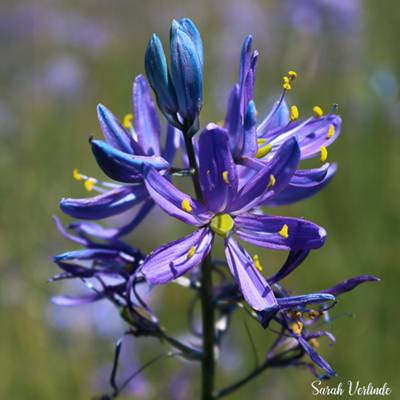Common Camas
Camassia quamash – Common Camas
At a Glance:

- Family: Asparagaceae
- Plant Type: Flowering bulb
- Distribution: Western North America, California to British Columbia as far east as Montana
- Habitat: meadows, prairies, and hillsides that have moist early springs, can be cultivated like the ones on UWB/CC campus.
- Height: 0.2 – 0.7m tall
- Flower: flowers are lavender/purple/violet/deep blue with 6 petals (tepals).
- Flowering Season: April-June
- Leaves: green and fleshy, growing basally
- Generation: Perennial, dies back during winter
Restoration and Conservation
Elk, deer and moose graze the leaves in early spring. Gophers eat the camas bulbs and aid in the plant’s reproduction by breaking up and dividing the bulbs, and also caching them in other areas allowing them to reestablish in a new place. Great camas is an important flower for pollinating insects in prairie habitats.
Ethnobotany
The camas root is one of the most important foods to western North American native people. Camas root was often traded and people would travel great distances to find and harvest it. Camas root is considered to be semi-agricultural by some. Families could own patches of land where only they could harvest the root. People would prepare the areas where it grew by weeding, clearing, and in some cases burning the area. The roots were harvested at certain times of the year, mostly during the summer after the camas had flowered, but some harvested it in the spring. The harvesting technique of camas also helped its growth, by overturning the soil to find the roots the soil was kept loose allowing for easier growth. Camas root did not keep fresh very long and were sun dried to preserve them. The dried roots were rehydrated overnight and also used in cooking as a sweetener.
References and Resources
- USDA: https://plants.usda.gov/plantguide/pdf/cs_caqub2.pdf
- WTU Image Herbarium: http://biology.burke.washington.edu/herbarium/imagecollection/taxon.php?Taxon=Camassia%20quamash
This article was written by Jessica Rouske and Sarah Verlinde. For questions regarding the UWB/CC Plant Tour, contact Sarah at severlin@uw.edu.
